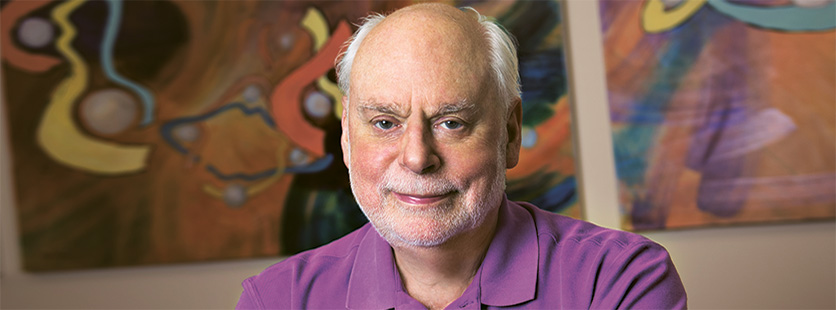
A Bridge to the Invisible
Nobel Prize Winner Sir Fraser Stoddart on the art that inspires his science
When Weinberg College Professor Sir Fraser Stoddart won the 2016 Nobel Prize for Chemistry in October, he drew international attention for his creation of molecular machines such as the world’s tiniest elevator and an artificial pump. Stoddart’s wondrous inventions will impact our world in ways beyond imagining, from medicine to information technology to energy storage.
We can never see Stoddart’s nanomachines, which are one thousand times smaller than the width of a single human hair, with the naked eye. Yet we can find Stoddart’s inspiration for their tiny forms all around us in art and the humanities, which provide an interdisciplinary bridge between the invisible and the visible.
As Stoddart began to design and synthesize molecular compounds early in his career, his imagination turned to the worlds of art, design, architecture and fashion, which gave him a visual language to express groundbreaking ideas in chemical contexts. Nothing was off limits: he looked to Renaissance paintings, ancient Roman mosaics and Stone Age sculptures, as well as jewelry, ties, belts, nets and a baby’s rattle to explore fundamental concepts through the joining of shapes.
Stoddart’s love of the humanities is not limited to the visual arts. True to his Scots upbringing, Stoddart is fond of quoting the poet Robert Burns and can summon the words of Noel Coward and Shakespeare with ease. As the United Kingdom’s Sunday Times stated in 2007, Stoddart “is to nanotechnology what J.K. Rowling is to children’s literature.”
“My real empathy with chemistry was much more about corresponding interactions with art and culture,” Stoddart explains. “That is what has driven me to chemistry … that wonderful ability to express oneself in artistic form.”
His earliest inspiration came from the gracefully intertwining forms of Celtic art, found in his native Scotland. An only child, he spent the first 17 years of his life on a farm with no electricity and became a big fan of jigsaw puzzles.
“I dabbled a little with a chemistry set on the farm, but soon lost interest in bangs and smells. I was more interested in colors and crystals and those kinds of things.”
Stoddart went on to attend the University of Edinburgh, where he earned a bachelor’s degree in 1964, a Ph.D. in 1966, and a Doctor of Science in 1980. He found likeminded collaborators in Jean-Pierre Sauvage of the University of Strasbourg and Bernard Feringa of the University of Groningen, the chemists with whom he shares his Nobel Prize. His first major breakthrough took place in 1991, when he and his colleagues at the University of Birmingham synthesized a “rotaxane”— a ring molecule wrapped around a dumbbell-shaped axle, called a molecular shuttle. The ring slides back and forth along the dumbbell, like a bead on an abacus.
This tiny machine was inspired by the work of Sauvage, with whom Stoddart often joined forces.
“I like to say that there are no firsts in science; you’re always standing on the shoulders of giants. It’s the same in the art world,” Stoddart says.
The rotaxane led to more remarkable creations. Of all the interlocking chemical entities Stoddart has developed (including the trefoil knot with Sauvage and a replica of the five-ringed symbol of the Olympic Games), perhaps the most symbolically meaningful are the Borromean rings. This topology consists of three rings that are joined in such a way that breaking any single ring will free all the rings.
Stoddart points to the pattern of Borromean rings that appear throughout history: on 9th-century Viking rune stones, on sculpted stone pillars in a temple in Chennai on the east coast of India, in stained-glass windows in St. Vitus Cathedral in Prague, and on Pallas Athena’s dress in Botticelli’s Pallas and the Centaur from 1480. During the Renaissance, Borromean rings symbolized strength in unity, particularly the strong bonds created through intermarriage among powerful families.
This theme of strength in unity turns out to be an apt metaphor for Stoddart’s belief in the power of a diverse community of committed scientists. He speaks enthusiastically of his international colleagues and the students he has taught over the years, scholars who came from all over the world and who now work in different fields of chemistry in institutions spanning the globe. “There is so much to be had from bringing people together from different backgrounds,” says Stoddart, who was knighted by Queen Elizabeth II in 2006 for his contributions to molecular nanotechnology. Two years later, he joined the College’s Department of Chemistry.
Stoddart notes that creative people need to be in the right environment to flourish and make their best contributions. “In 1905, artists and writers went to Paris. They were looking for the right milieu. Northwestern is now a hub of creativity in chemistry and materials science. It is a place where people want to leave their mark.
“Creativity is rarely the product of a single moment,” he adds. “Perhaps more often it is the result of a lifetime.”
Back to top